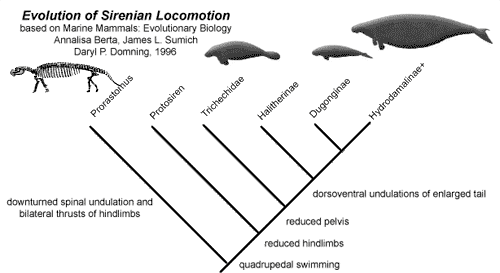The Evolution
When the supercontinent Pangaea broke apart about 180 million years ago, small basal mammals
*)such as the shrew-like Eomaia

already crawled in the shadow of the dominant dinosaurs. On the separating continents Gondwana
*)Africa, South America, Australia, Antarctica, India and Laurasia
*)now Europe, Asia except India, North America they developed into the very divergent groups of mammals we know today. In Africa for instance, which was isolated for many million years, arose 100 Million years ago the weird clade of the Afrotheria: the elephants, hyraxes, aardvarks, and seacows. Afrotheria therefore are the oldest group of the
Eutheria or Placental Mammals
Approximately 65 million years ago a ten kilometer wide asteroid hit the Gulf of Mexico, as consequence of this catastrophic event the dinosaurs died out. This was the beginning of the ongoing "Age of Mammals", they filled the ecological niches vacated by the dinos, and their numbers exploded.
Age of Mammals:
Epoch Key of the Cenozoic Era
| Tertiary |
Quaternary |
| Paleocene |
Eocene*)dawn of modern mammals |
Oligocene |
Miocene |
Pliocene |
Pleistocene |
Holocene |
65-56
mya |
55-34
mya |
34-23
mya |
23-5
mya |
5-1,8
mya |
1,8-0,01
mya |
10 000-
today |
The origin of the sirens is uncertain.
The most archaic, about 50 million year old, sirenian fossil was found 1855 in Jamaica, consisting of a skull, mandible, and some vertebrae. R. Owen named it Prorastomus sirenoides.
In the “Encyclopedia of Marine Mammals” of 2002 we read,
In 2001, also in Jamaica, a team under Daryl Domning
 Composite skeleton of Pezosiren portelli
Composite skeleton of Pezosiren portelli
(after D. Domning)
excavated a near complete skeleton of a Prorastomid of early middle Eocene, slightly younger than the foregoing. Domning named the animal
Pezosiren portelli. It was a pig-sized animal with a length of about two meters, which still possessed front and hind legs. It was obviously capable to walk on land. Other characteristics, however, suggest that it spent most of its time in the water, eating seagrasses.
From there on the seacows became a very successful animal order, which in the Oligocene populated all warm shallow seas in great varieties and numbers. Very soon the tail end evolved into a powerful horizontal fluke, and the rear extremities regressed.
 (public access image, Prorastomus depiction added by H. Rothauscher)
(public access image, Prorastomus depiction added by H. Rothauscher)
Someday in early Miocene the Caribbean Dugongid species Dusisiren reinharti entered the North Pacific through the then open Central American seaway, and without branching developed into the new dugongid subfamily of the Hydrodamalinae.
Toward the end of the Miocene the climate deteriorated and the earth climate cooled. Seagrass, the main food of the sirens, disappeared in the northern Pacific, and large brown algae were spreading instead. Our Hydrodamalinae adapted to the changed food supply and the colder habitat.
For thermal efficiency they developed thick blubber and a bark like skin. They became cold tolerant, huge, and bulky animals. At the same time their molars regressed with the soft kelp diet.

